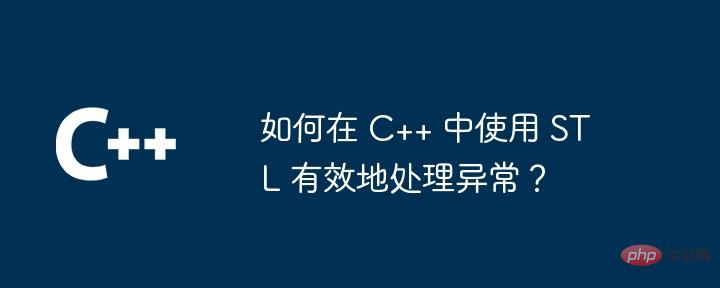
Effective use of STL exception handling: Use try blocks in blocks of code that may throw exceptions. Use a catch block to handle specific exception types, or a catch(...) block to handle all exceptions. Custom exceptions can be derived to provide more specific error information. In practical applications, STL's exception handling can be used to handle situations such as file read errors. Follow best practices, handle exceptions only when necessary, and keep exception handling code simple.

#How to effectively handle exceptions in C++ using STL?
Exception handling is crucial for handling runtime errors and restoring the execution flow. The C++ Standard Library (STL) provides a rich exception handling mechanism to enable developers to handle exceptions effectively.
Basic usage of exceptions
To handle exceptions, you need to perform the following steps:
try blocks. catch blocks to handle specific exception types. catch(...) block to handle all exceptions. Example: Divide by zero
try {
int x = 0;
int y = 5;
int result = y / x; // 引发异常
} catch (const std::runtime_error& e) {
std::cerr << "运行时错误:" << e.what() << "\n";
}Custom exception
You can use std:: exception class derives custom exceptions.
class MyException : public std::exception {
public:
explicit MyException(const char* message) : std::exception(message) {}
};Exception handling practical cases
In the following cases, STL's exception handling is used to handle file read errors:
try {
std::ifstream file("data.txt");
if (!file.is_open()) {
throw std::runtime_error("无法打开文件");
}
// ... 其他文件操作 ...
} catch (const std::runtime_error& e) {
std::cerr << "文件错误:" << e.what() << "\n";
}Best Practice
catch() blocks. The above is the detailed content of How to handle exceptions efficiently in C++ using STL?. For more information, please follow other related articles on the PHP Chinese website!
 What are the differences between c++ and c language
What are the differences between c++ and c language
 Recommended learning order for c++ and python
Recommended learning order for c++ and python
 Cost-effectiveness analysis of learning python and c++
Cost-effectiveness analysis of learning python and c++
 Is c language the same as c++?
Is c language the same as c++?
 Which is better to learn first, c language or c++?
Which is better to learn first, c language or c++?
 The difference and connection between c language and c++
The difference and connection between c language and c++
 C++ software Chinese change tutorial
C++ software Chinese change tutorial
 Cost-effectiveness analysis of learning python, java and c++
Cost-effectiveness analysis of learning python, java and c++




